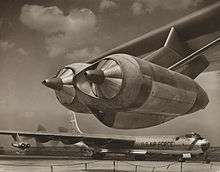General Electric J47
The General Electric J47 turbojet (GE company designation TG-190) was developed by General Electric from its earlier J35.[1] It first flew in May 1948. The J47 was the first axial-flow turbojet approved for commercial use in the United States. It was used in many types of aircraft, and more than 30,000 were manufactured before production ceased in 1956. It saw continued service in the US military until 1978. Packard built 3,025 of the engines under license.
| J47 | |
|---|---|
 | |
| Preserved General Electric J47 | |
| Type | Turbojet |
| Manufacturer | General Electric |
| First run | 21 June 1947 |
| Major applications | Boeing B-47 Stratojet Convair B-36 Peacemaker North American F-86 Sabre North American B-45 Tornado |
| Number built | 36,500 |
| Developed from | General Electric J35 |
| Developed into | General Electric J73 |
Design and development
The J47 design used experience from the TG-180/J35 engine which was described by Flight magazine in 1948[2] as the most widely used American-conceived turbojet.
Overhaul life for the J47 ranged from 15 hours (in 1948) to a theoretical 1,200 hours (625 achievable in practice) in 1956. For example, the J47-GE-23 was rated to run 225 hours time between overhauls. As installed on the F-86F, it experienced one in-flight shutdown every 33,000 hours in 1955 and 1956.[3]
Variants
- J47-GE-1
- (TG-190A) 4,850 pounds-force (22 kN) thrust.[4]
- J47-GE-2
- (TG-190E) 6,000 pounds-force (27 kN) at 7,950 rpm, powered the North American FJ-2 Fury[5]
- J47-GE-3
- (TG-190A) 4,850 pounds-force (22 kN) thrust.[4]
- J47-GE-7
- (TG-190B) 5,000 pounds-force (22 kN) thrust.[4]
- J47-GE-9
- (TG-190B) 5,000 pounds-force (22 kN) thrust.[4]
- J47-GE-11
- (TG-190C) Powered the Boeing B-47A and B-47B[5]
- J47-GE-13
- (TG-190C)Powered the North American F-86E Sabre & North American B-45C tornado[5]
- J47-GE-15
- (7E-TG-190C) Powered the North American B-45C tornado[5]
- J47-GE-17
- (7E-TG-190D) 5,425 pounds-force (24 kN) at 7,950 rpm dry, 7,350 pounds-force (33 kN) at 7,950 rpm wet, powered the North American F-86D Sabre[5]
- J47-GE-17B
- 5,425 pounds-force (24 kN) thrust
- J47-GE-19
- (TG-190C) 5,200 pounds-force (23 kN), powered the Convair B-36D & B-36F[5]
- J47-GE-23
- (7E-TG-190E) 5,800 pounds-force (26 kN), powered the Boeing B-47B and RB-47B[5]
- J47-GE-25
- 5,970 pounds-force (27 kN) thrust dry, (6,970 pounds-force (31 kN) with water injection), powered the Boeing B-47E and RB-47E[5]
- J47-PM-25
- (TG-190E) Production by Packard Motor Car Company
- J47-ST-25
- (TG-190E) Production by Studebaker Corp.
- J47-GE-27
- (TG-190E) 5,970 pounds-force (27 kN) thrust, powered the North American F-86F Sabre[5]
- J47-GE-29
- (TG-190E) Similar to -27
- J47-GE-33
- 5,550 pounds-force (25 kN) thrust, powered the F-86F & F-86K[5]
Applications

- Boeing B-47 Stratojet
- Boeing KB-50J Superfortress
- Boeing KC-97 Stratofreighter
- Chase XC-123A
- Convair B-36 Peacemaker
- Convair NB-36
- Curtiss XF-87 Blackhawk
- Martin XB-51
- North American B-45 Tornado
- North American F-86 Sabre
- North American F-86D Sabre
- North American FJ-2 Fury
- Republic XF-91 Thunderceptor
Ground-based vehicles that used the engine include:
- Spirit of America
- M-497 Black Beetle jet-powered railcar
The nuclear-powered X39
In the 1950s, interest in the development of nuclear-powered aircraft led GE to experiment with two nuclear-powered gas turbine designs, one based on the J47, and another new and much larger engine called the X211.
The design based on the J47 became the X39 program. This system consisted of two modified J47 engines which, instead of combusting jet fuel, received their heated, compressed air from a heat exchanger that was part of the Heat Transfer Reactor Experiment (HTRE) reactor. The X-39 was successfully operated in conjunction with three different reactors, the HTRE-1, HTRE-2 and HTRE-3.[6] Had the program not been cancelled, these engines would have been used to power the proposed Convair X-6.
Specifications (J47-GE-25)
Data from [5]
General characteristics
- Type: turbojet
- Length: 145 inches (370 cm) (with tailcone)
- Diameter: 36.75 inches (93.3 cm) maximum
- Dry weight: 2,554 pounds (1,158 kg) dry, equipped
Components
- Compressor: 12-stage axial compressor
- Turbine: single-stage axial
- Fuel type: JP-1, JP-2, JP-3, JP-4 or MIL-F-5572 gasoline
- Oil system: pressure feed spray with scavenge
Performance
- Maximum thrust: 5,970 lbf (26.56 kN) at 7950 rpm ; 6,970 lbf (31.00 kN) with water injection
- Overall pressure ratio: 5.35
- Air mass flow: 92 lb/s (42 kg/s)
- Specific fuel consumption: 1.014 lb/(lbf⋅h) (28.7 g/(kN⋅s))
- Thrust-to-weight ratio: 2.34 at take-off dry power
See also
- United States military aero engine designations
Related development
Comparable engines
Related lists
References
- https://www.flightglobal.com/pdfarchive/view/1954/1954%20-%200996.html
- https://www.flightglobal.com/pdfarchive/view/1948/1948%20-%201229.html
- 1956 | 0590 | Flight Archive. Flightglobal.com. Retrieved on 2013-08-16.
- Wilkinson, Paul H. (1950). Aircraft engines of the World 1950 (11th ed.). London: Sir Isaac Pitman & Sons Ltd. pp. 54–55.
- Bridgman, Leonard (1955). Jane's all the World's Aircraft 1955-56. London: Jane's all the World's Aircraft Publishing Co. Ltd.
- Thornton, G; Blumbeg, B. (January 1961). "Aircraft Nuclear Propulsion Heat Transfer Reactor Experiments Fulfill Test Goals". Nucleonics. McGraw-Hill. 19 (1). ISSN 0096-6207.
- Gunston, Bill (2006). World Encyclopedia of Aero Engines, 5th Edition. Phoenix Mill, Gloucestershire, England, UK: Sutton Publishing Limited. ISBN 0-7509-4479-X.
- Kay, Anthony L. (2007). Turbojet History and Development 1930-1960 Volume 2:USSR, USA, Japan, France, Canada, Sweden, Switzerland, Italy and Hungary (1st ed.). Ramsbury: The Crowood Press. ISBN 978-1861269393.
- http://www.flightglobal.com/pdfarchive/view/1956/1956%20-%200590.html
External links
| Wikimedia Commons has media related to General Electric J47. |